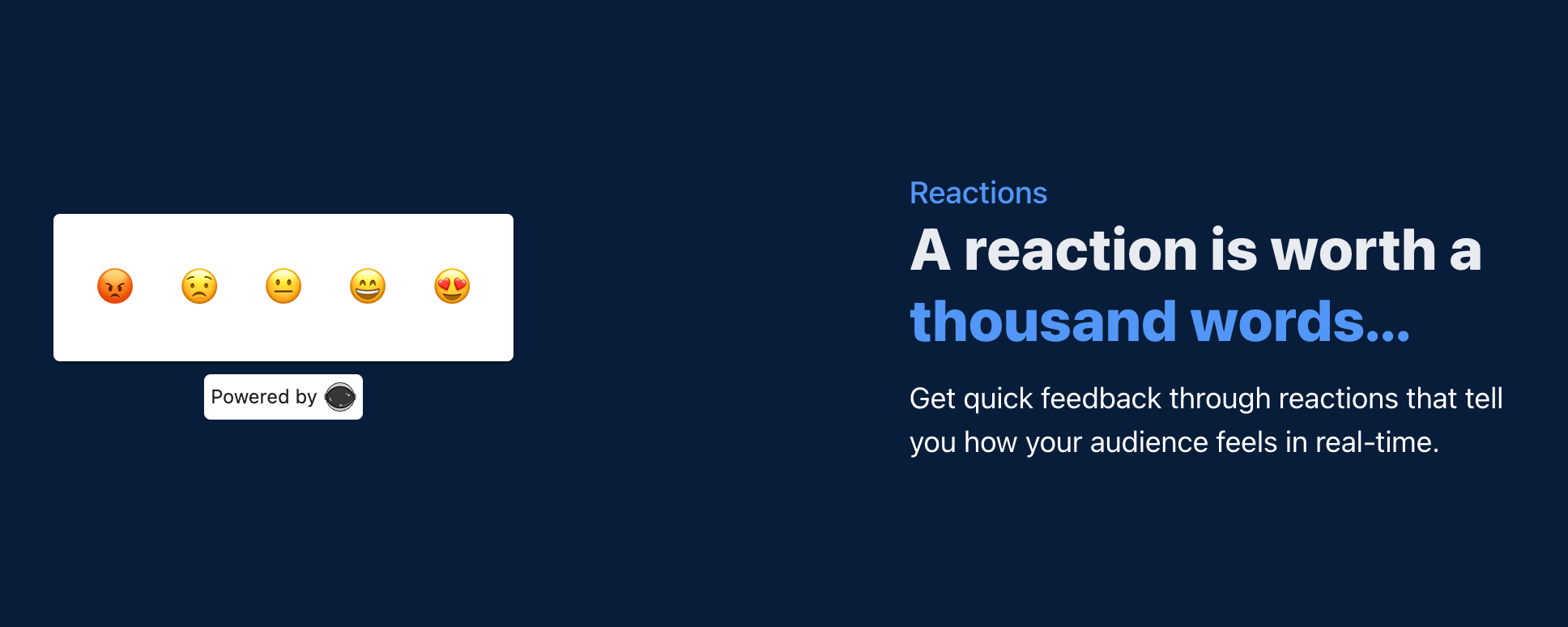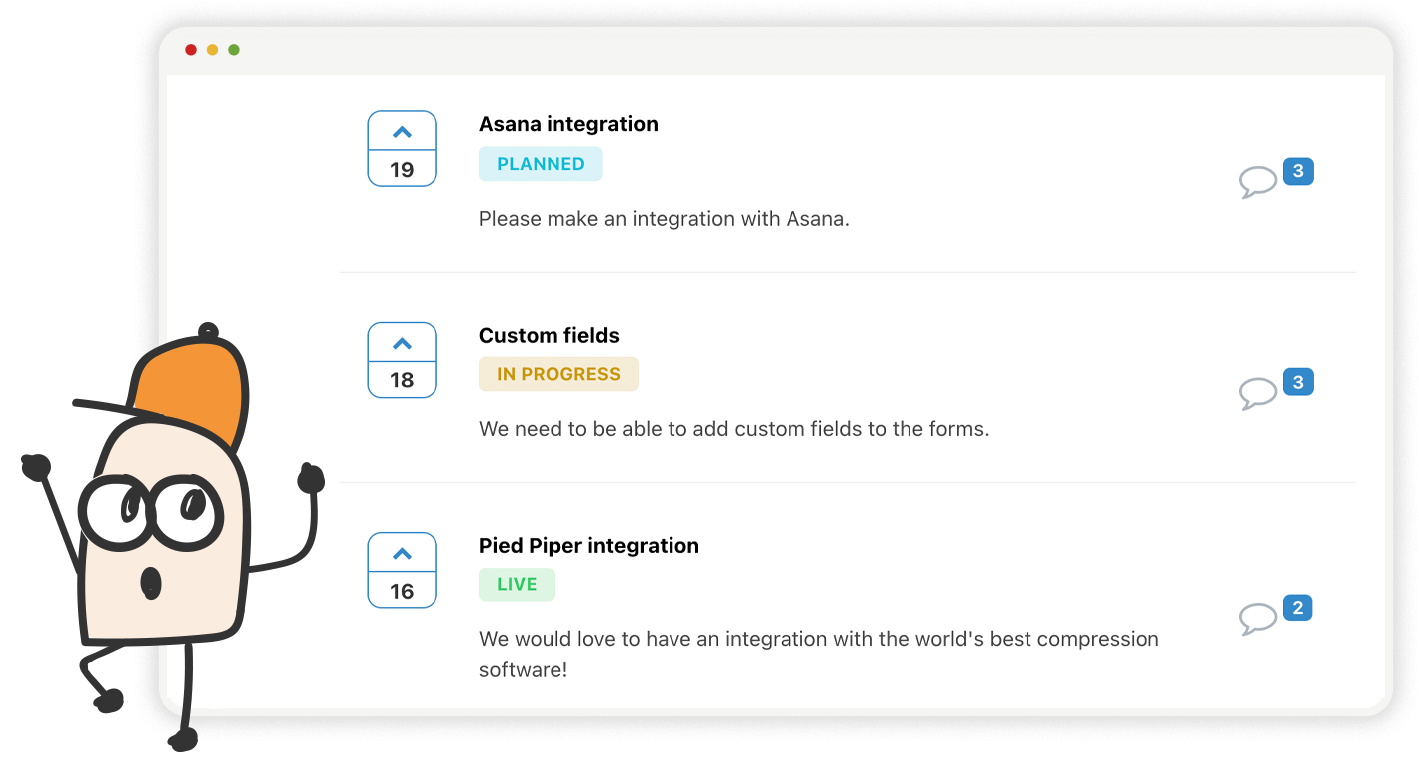2022-03-13
How to collect customer feedback for your website
Collecting customer feedback is essential to any successful business. But if you're reading this article, I assume that you already know that.
In this article, you'll learn about the different options available to get feedback from the people that visit your website.
Table of Contents
8 ways of collecting customer feedback
Let's dive right into the different ways of collecting customer feedback, but stick around for the second section of the article, where we will see how to categorize and organize your feedback.
Surveys

TypeForm allows you to create beautiful surveys with multiple questions.
Surveys are the most popular way of asking for feedback as they give you detailed insights into what customers think about a given topic.
With tools like Typeform, you can create beautiful conversational surveys that don't feel like work to your customers.
Even though surveys give you a good picture of your customers, it can be hard to get users to participate.
One solution to this problem is to organize giveaways, which will give an incentive to the participants to complete the survey.
Use surveys if you...
- ...need detailed feedback from your customers.
- ...are willing to create an incentive like a giveaway.
- ...already have a good relationship with your customers.
Polls

PollPilot allows you to create beautiful and embeddable polls to ask your audience at the right time.
Although polls are similar to surveys, they aren't quite the same:
Typically, polls consist of one multiple-choice question, while surveys allow you to ask multiple questions in a row.
Polls serve a different purpose than surveys as they focus on getting more responses from your audience.
Because giving feedback through a poll is quick in nature, it can be easily integrated into blog posts, next to new features, or in emails.
With PollPilot, if you want to get more detailed feedback, you can ask your customer for an email address and follow up with a detailed survey afterward.
Use polls if you...
- ...want to get answers to a specific question.
- ...want to get contextual feedback on your blog posts, landing pages, or features.
Emails are a great way to collect feedback, too. Whether you have a website, blog, SaaS business, you most likely also have an email list that you use to contact your users.
You can use polls or reactions to get feedback on your sent-out emails, or you can reach out to your users for direct feedback.

Example of how embedding a feedback widget may look like.
Adding a reaction to the bottom of each of your transactional and marketing emails gives you an idea of how your readers perceive these emails.
If some emails are performing poorly, you can dig into why that is by looking at the messages people left after giving feedback.
Additionally, you can reach out to them directly and ask them what upset them.
Sometimes, having a conversation with individual customers can give you much better insights than all the tools discussed in this article.
Use email for feedback if you...
- ...want to know how readers perceive the quality of your emails.
- ...get into a deeper discussion with your customers.
Emoji Reactions

Reactions are a great way to measure customer satisfaction.
Having a reaction widget below your blog posts or features incentivizes users to give feedback even more than text-based polls.
Make sure to follow up with further questions, though, as it can be hard to pinpoint why users select a given option.
As discussed above, including reaction polls in your emails can help you make better decisions in your marketing campaigns.
Use emoji reactions if you...
- ...want to get contextual feedback on your blog posts, landing pages, or features.
- ...want to make your blog more interactive.
Analytics
Analytics are the most commonly used method of getting feedback from users.
Despite not asking users for feedback directly, they can still give us a good idea of how we're doing.
A blog, for instance, might be measured by the number of page views or sessions.

Looking at numbers sure feels good sometimes.
Looking at what content is doing better than the rest can tell us what we need to do more of.
However, only looking at page views can be misleading, and optimizing solely for page views can easily backfire.
Sites like BuzzFeed, for example, optimize for page views because they get paid per ad impression.
The resulting content is often rehashed from existing pieces, clickbaity, and low quality.
Instead of focusing on page views, looking at other metrics, like comments or social shares, can help you improve or maintain a certain quality.
Additionally, you can complement these numbers with reactions, polls, and surveys, to get further insights into what your audience likes or dislikes about your content.
Use analytics if you...
- ...want to know how many people visit your site, where they come from, and what pages they visit.
- ...want to track metrics like conversion rates, click-through rates, and more.
- Complement analytics with other feedback tools to get a better idea of where you stand in terms of quality.
Customer interviews
We tend to focus too much on data without considering that we are dealing with other people whose opinions may not be perfectly reflected by any metrics.
Having a conversation with your customers gives you insights and nuances to your existing data as no other method on this list.
When talking to customers, don't try to sell them anything. You can steer the conversation in a direction, but don't make it about your product or ideas.
If you want to learn how to conduct interviews like that, I'd recommend you check out the book "The Mom Test", which gives practical advice for anyone trying to get into customer interviews.
Use customer interviews if you...
- ...want to know what your (potential) customers care about.
- ...want to validate your ideas.
Usability tests
Usability testing is a UX research methodology that requires a lot more preparation and planning than the other ways of collecting customer feedback.
A researcher (also called facilitator or moderator) tells the participants to perform a task using some user interface.
The researcher observes the participants while completing the task, observing how they behave and collecting feedback.
This methodology can help you identify the problems and opportunities within your UI. It also helps you to learn more about your users and how they react to your product.
Given the effort it takes to organize something like this, this method may be better suited for companies that have been in business for a while and aim to improve their existing product.
If you want to learn more about this method, you can continue reading this article.
Use usability tests if you...
- ...need high-quality user feedback.
- ...have a network of users or friends that would participate.
- ...are willing to spend the time and other resources for getting feedback.
Feature voting

Tools like Upvoty allow your users to vote and suggest new features.
Allowing your users to propose and vote on potential features integrates perfectly into the lean software development methodology.
Use feature voting if you...
- ...want to allow your users to shape your roadmap.
- ...are willing to spend the time and other resources for getting feedback.
Quantitative vs. Qualitative feedback
Now that we've covered the different ways of collecting feedback let's take a step back to see how we can make sense of this.
We can split the abovementioned methods into two categories: quantitative and qualitative feedback.
Both of them work hand in hand and together, they can give us a good idea of the state of our business.
Quantitative feedback
Polls, surveys, reactions, and analytics are all quantitative feedback methods.
These feedback tools are categorized like that because the feedback provides numerical results.
The metrics that these feedback tools give you quantify certain parts of your business and make things comparable.
You can use them to quantify the feedback of a marketing campaign or the satisfaction of your customers.
Qualitative feedback
Qualitative feedback focuses on the input of individuals, which can't be put into a number.
It goes beyond metrics and allows you to get a deeper understanding of why customers behave a certain way.
While it's harder to analyze, it gives you a better understanding of your customer's thoughts.
Where should I start?
Having all these different ways of collecting feedback can be overwhelming, especially if you're starting out.
If you have a blog, an excellent place to start would be adding a feedback widget under each of your articles.
The same goes for transactional and marketing emails. You will also want to collect feedback within your application if you have one.
Make sure also to collect customer emails after someone leaves a review. This will allow you to reach out to them for further feedback.
But don't just collect feedback. Make sure you review it regularly when making future decisions to improve your product.